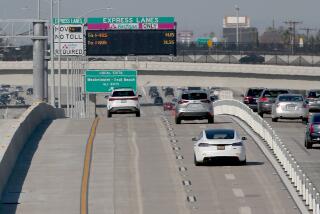Repair Bottlenecks: Better to Take Medicine All at Once
- Share via
It’s 95 degrees, and a blazing sea of red taillights stretches away in the heat-haze ahead.
It’s not like you were actually driving anywhere important.
Oh sure, you would rather arrive on time and duck the wrath of bosses, clients, loved ones, pastors, movie ushers, hairstylists and everyone else enslaved to foolish punctuality.
Or do you actually enjoy sucking exhaust fumes at 4 mph and macerating your clutch while you and 97,432 other cars per square inch do the rush-hour rumba?
Thought not. Well, tough.
Because there’s (a five-car fender-bender, an overturned trash truck, a lost load of pipe, a freshly flattened dog, a CHP officer writing a ticket, a total absence of anything distracting--insert your roadblock of choice here) clogging the freeway about nine miles ahead.
And you, dear reader, are doomed to crawl.
It’s your 45 minutes, to do with whatever your little heart desires.
Curse. Fume. Sweat. Mutter.
Curse some more. Pound the dashboard. Think up a believable excuse for not having left earlier. Rev your engine impatiently. Curse again as colorfully as you can at the top of your lungs because no one can really hear you with the windows up and it kind of feels good until you start laughing and swallow your gum and almost choke to death.
And remember: Patience is for war brides and bonsai gardeners. And poor saps like us, all geared up with nowhere to go.
****
Dear Street Smart:
Last month, Caltrans decided to replace the reflectors on the Ventura Freeway through Ventura County. They started in Thousand Oaks on a Saturday night and progressed toward Ventura, creating a complete bottleneck each night by closing two lanes at a time.
This whole thing seemed very poorly handled. For one thing, there was no indication of lane restrictions until the very last moment, when it was far too late to take an alternate route.
Caltrans closed very long sections of road while they were working, up to eight miles. They could have closed just a couple miles at a time while they put in new reflectors. At the very least, they could have waited until after midnight before restricting Ventura County’s main artery.
Rob Krohn, Simi Valley
*
Dear Reader:
Let’s put it this way. Would you rather swallow nasty-tasting medicine a drop at a time or all at once? Caltrans favors the latter approach:
“Caltrans maintenance crews regret that you were inconvenienced by the recent installation of raised pavement markers,” replies Pat Reid, spokeswoman for the California Department of Transportation. “Hopefully, the majority of drivers will appreciate the many safety advantages of having all-new markers to clearly delineate lanes in that stretch.”
Caltrans has no choice but to work nights and weekends in such heavily traveled corridors, when car and truck traffic is lighter, Reid says.
“The decision was made to complete the marker installation work by closing two lanes at a time, so the 10-person crews could get the work done faster [without] additional lane closures.”
As for earlier warnings, Reid says that standard Caltrans practice there--as everywhere--is to post trailer-mounted message signs one mile in advance of lane closures.
****
Dear Street Smart:
I am a Rio Mesa High School student in Oxnard, and every morning I spend an average of five to 10 minutes waiting in line to get through the stop sign on Central Avenue at Santa Clara Avenue from Camarillo.
I have tried detouring and reaching the stop sign from the west off Santa Clara, yet on some days, that takes just as long. To reach school on time, 8 a.m., I leave home at 7:30, and sometimes I am still pressed for time.
I believe the problem to be the amount of time spent having a four-way stop on an extremely crowded two-lane road. This could be drastically reduced simply by changing the sign to a stoplight. Please let me know if there is any possibility behind this suggestion.
Jennifer White, Camarillo
*
Dear Reader:
As Street Smart noted last month, and in earlier columns, this entire chunk of Santa Clara Avenue is due for repairs, starting by June 1 and ending by December.
“Ms. White is quite perceptive,” replies Loren Blair, a public works engineer for the county. “As it happens, we have a contract currently let for a traffic signal installation, plus construction of left-turn lanes at the intersection of Central and Santa Clara Avenue.”
So until it’s done, you’ll just . . . have . . . to . . . wait.
Infuriating, isn’t it? Try composing song lyrics, memorizing state capitals, reviewing homework problems in your head--anything to take your mind off the pace.
Because as a young driver, you’d better get used to this little fact of life: High-speed rush-hour cruising in Southern California is about as real as an alien spaceship with a crew of 40 cultists lurking behind the Hale-Bopp comet.
****
Dear Street Smart:
Thank you for printing my letter in your column on Monday, May 5.
I am writing to tell Thousand Oaks traffic engineer Jeff Knowles which traffic light I was referring to: It is located at the intersection of Lynn and Janss roads.
As I said before, every day, I come down Janss Road to go to school. That light takes forever! I have asked a lot of people for their opinions, and they all agree. My teacher agrees.
I’m not saying you need to take all your time to put in a new traffic light, just try to put in a sensor so we won’t always have to stop and wait so long.
Jenna Kwiatkowski, Thousand Oaks
*
Dear Reader:
Thanks for writing back to clarify your earlier letter.
Unfortunately, we doubt you’ll be too happy about Knowles’ answer, now that he (and Street Smart) understands which intersection you were writing about.
Knowles’ crews have tuned the traffic timers so the cycles are just about as short as they can be. There are about 90 seconds between the start of the red light and the end of the next green light, Knowles says. That means the wait for anyone on Janss Road--at any intersection, because the lights are all synchronized--is about 45 seconds or less, he says.
And compared with other county cities such as Ventura or Simi Valley--which have light cycles lasting up to 150 seconds--90 seconds is short, Knowles says.
“If they still feel 45 seconds [on red] is an inordinate amount of time, there’s not a whole lot I can do, because there’s a tremendous amount of traffic moving up and down that street,” he says.
But listen: Take a stopwatch next time you go to school and time the light. If that red light lasts much longer than 45 seconds, please write back.
NEXT: Whoops.
More to Read
Sign up for The Wild
We’ll help you find the best places to hike, bike and run, as well as the perfect silent spots for meditation and yoga.
You may occasionally receive promotional content from the Los Angeles Times.






